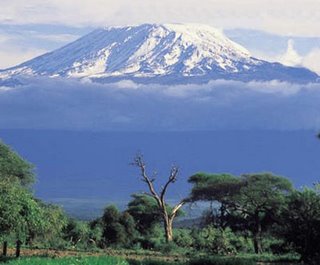Journey to Mt Kilimanjaro
Reach high, for stars lie hidden in your soul. Dream deep, for every dream precedes the goal. - - - -Ralph Vaull Starr
Only three more sleeps
I am so excited that I can no longer sleep at night. I feel a bit like a kid waiting for Santa! This will be my last posting before we leave on Saturday so please pop back later and have a look at the trek photo's.
A short note from a friend of the Bean's:
Hi folks!
My name is Merethe Moen and I am from Grimstad, Norway. I am married to Jarle and together we have two boys, both aged 4 1/2( the 1/2 is very important :-) )In 1997 we travelled almost 7 months around the world. And in doing so, we also climbed Kilimanjaro together. We were extremely lucky with the weather!!! The sunrise was fantastic, and the view.......you just have to see it! Enjoy!!The climb went almost as planed, except for my husband who experienced altitude problems. He described it as the hangover from hell, but, as stubborn as he is, he made it to the top. It was a wonderful experience, and we met a lot of nice people. Next challenge for you all:Svalbard, Norway. Experience the midnight sun, glaciers and polar bears (usually not talkative ;-) ). Good luck to you alle! May the weather-gods be on your side!Best Regards Merethe
A little info about the mountain

Rising 19,340 ft high, snow capped and wreathed in veils of clouds, stands
Mt. Kilimanjaro, the highest mountain in Africa and one of the largest free standing mountains in the world.

Kilimanjaro has three extinct volcanoes:
Kibo (19,340 ft.)
Mawenzi (17,000 ft.)
Shira (13,000 ft.).
Views of the surrounding landscape are spectacular from all the three peaks. The East African Rift valley is visible from Kibo, the highest of the three peaks of the majestic Mt. Kilimanjaro.
Scaling Mt. Kilimanjaro takes you through five distinct clmates that are appoximately 3,300 ft. apart. Each climate varies in rainfall, temperature, flora, and fauna.
A brief description of each follows, while a picture chart of the more common species of flower can be found at the end of the blog.
Cultivated zone and forest (800m - 280m)
The forest zone, along with the cultivated zone that lies below it, together receive the most rainfall - about 2300mm per year - of any part of the mountain. Enormous camphorwoods flourish at this altitude, as do fig, and around Marangu Gate, the grey-barked podocarpus. Hanging from the trees you will find pink and white Begonias that fill the area with thier sweet smell. On the dier northern and western slopes juniper and olive trees proliferate. The star of this zone is the Impatiens kilimanjari, an endemic, it is red and yellow and in the shape of an inch long tuba.
Heath and moorland (2800m - 4000m)
These two zones overlap, and together occupy the area immediately above the forest from around 2800m to 4000m - also known as the low alpine zone.
Temperatures can drop below zero degrees celcius at this altitude, and most of the precipitation that does fall here comes from the fog and mist that are almost permanent fixtures at this height. Immediately above the forest zone is the alpine heath. Rainfall here is around 1300mm per year. Erica's grow in abundance. Climbing higher, grasses beging dominate the mountain slopes with only a few smaller species of protea add colour. Near the top of this zone, you'll begin to come across sedges and start to notice that the shrubs are shrinking in size.
Alpine desert (4000m-5000m)
By the time you reach the saddle, only three species of tussock grass and few everlastings can withstand the extreme conditions. In the alpine desert plants have to survive in drought conditions (precipitation here is less than 200mm per year), and put up with both inordinate cold and intense sun, usually in the same day. One little daisy the Asteraceae manages to bloom up to about 4700m.
Ice cap (5000m-5895m)
On Kibo, almost nothing lives. There is virtually no water. A few mossess and lichens are said to exist all the way to the summit. While these lichen may not be the most spectacular of plants, it may interest you to know that their growth rate on the upper reaches of Kilimanjaro is estimated to be just 0.5mm in diameter per year.
 |  |  |  |
You can reach the summit via five different routes through the five vegetation zones.
About the author

Well, who said woman can't also have a mid life crises?
What else could have prompted me to make the decision to loose 15kg's and then as if that is not bad enough decide to climb Mt Kilimanjaro for the thin photo!
Every good intention should have a before and after photograph so here is the "fat photo" sorry guys - I will save the full body shot for after the diet. Check back in January 2007 to see if I made it or not.
I will be trekking with a group of guys and girls from 3rd Pinelands Scout troup. Hence the URL for the blog. I am certain a few photo's of the other guys will get posted during our training half year. My husband Mark will be doing all the moral support and baby sitting needed to allow a working mom the luxury of all the time off from maternal duties to do the required training. Thanks my love.

O.K so now you have worked out that I am married, have a daughter and am in the process of a mid-life crises. That's enough about me. My daughter Sarah is in grade 1 at Kirstenhof primary school in Cape Town and is the coolest kid a mom could hope for. Mark and I have been married for 13 years this year and how he puts up will all my idiosyncrasies I have yet to find out. Don't know what I would do without him really.





 Proudly South African
Proudly South African